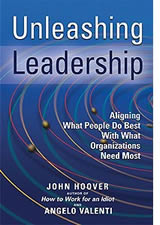Unleashing Leadership
Unleashing Leadership
Introduction
"Leadership is a potent combination of strategy and character.
But if you must be without one, be without strategy."
Norman Schwarzkopf
The character of your organization is the composite character of your staff. If 20 percent of the people in your organization do 80 percent of the work and vice versa, does that mean 80 percent of your organizational population are lazy? Are 80 percent of your people lacking in virtuous character? We don't think so. It's much more likely that 80 percent of the people in your organization are not properly aligned with your expectations for, or the needs of, your enterprise. Alignment is the key.
The greatest potential of your organization is tied directly to aligning what your people do best with what your organization needs most. Choosing team members based on softball batting averages, golf and bowling handicaps, cookie recipes, fashion choices, or other, equally-inappropriate criterion is self-defeating behavior. But, how would you know any better? Until you start asking the right questions, you won't.
How would your organization perform if everyone accepted leadership responsibility? How differently would your organization behave if leadership were an expectation of everyone, not an exception for the anointed few? The most distinguishing characteristic between thriving enterprises and struggling enterprises is the presence and quality of leadership at all levels.
You'll be happy to know that you have all the leadership potential needed in your organization right now to increase performance, productivity, and profits—and to sustain the increases. Unfortunately, the vast majority of your organization's leadership potential is probably locked up behind the bars of bureaucracy or staggering under the weight of organizational inertia. This doesn't happen by chance. The cultural dragon you're fighting feeds on old school notions about leadership that grew out of a Napoleonic, hierarchical military organizational model.
Hierarchical organizations are typically run by…well…little Napoleons and Napoleonettes; especially at mid-organization level. They're cute, especially the way they prop their hands under the lapels of their jackets; but they're not good leaders for the 21st Century. It's not their fault. The old leadership school taught that organizations are made up of officers and enlistees; the more powerful and the less powerful; superiors and subordinates. A hierarchical organizational design draws leadership focus and energy away from problem solving and progressive thinking by encouraging those climbing the organizational food chain to focus instead on protecting their positions, perks, and territory.
Leadership is a circle not a ladder. Inverting this traditional pyramid of institutionalized defensiveness and territoriality requires a premeditated, purposeful, intentional, and methodical leadership system that aligns what people do best with what organizations need most. The ComposiTeam™ Leadership System is designed to do exactly that, and finishes what the movement for flattened organizations, shared responsibility, and distributed leadership responsibility started. It does all this with remarkably sophisticated three-step, simplicity:
Create a database that identifies the leadership styles and motivations of everyone in your organization.
Profile the jobs, tasks, projects, objectives, and initiatives your organization needs executed.
Match the composite leadership profile of a leadership team to the initiative profile.
With that, the stage is set to focus everyone's unique talents and abilities on making your organization thrive as never before. Not by luck; nor chance; nor edict from on high; but from a well-designed and engineered leadership system that ties everyone in your organization to the truth of the past, the irreplaceability of the moment, and the promise of the future. Without these things, much in the way of time, energy, and resources will be wasted in an effort that might take you someplace you had no intention of going, at a price you had no intention of paying, and with more unintended than intended consequences.
An intentional, methodical, well engineered leadership system is your best hope for taming your organizational dragon. The leadership system outlined in this book can unleash tremendous stored up leadership potential in your organization. The same knowledge that will greatly diminish fear's power to hold people back will become a system for building and sustaining effective working relationships.
